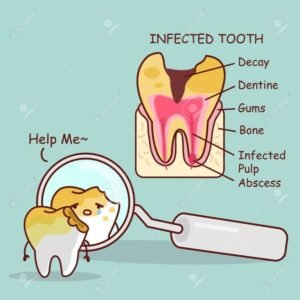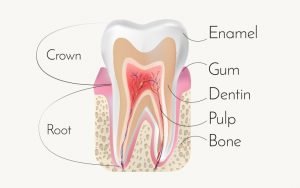
Root Canal
CONFIDENT SMILE THROUGH BETTER DENTISTRY
WHAT IS ROOT CANAL?
A Root Canal is needed when damage occurs to a tooth’s pulp.This can happen due to an injury or due to severe tooth decay. A root canal is often a dreaded procedure but is often the only alternative to having a tooth extracted. Root canals are also very effective at eliminating tooth pain.
TOOTH STRUCTURE
TOOTH DECAY
If the Tooth Decay is limited till the first two layers of the tooth it can be treated with filling/restoration,But when the infection reaches the pulp it needs intensive treatment
This occurs mostly due to deep decay, extensive restorations involving pulp, cracked or fractured tooth due to trauma, excessive wear of enamel, and dentin exposing the pulp, sometimes as a result of severe gum infections.
Signs of pulp damage may include pain, prolonged sensitivity to heat or cold, discoloration of the tooth, swelling, tenderness of the overlying gums or a bad taste in the mouth and etc

ROOT CANAL PROCEDURE
While Root Canals can take two or more appointments, the team will work to make each appointment as comfortable as possible for you. At THE DENTIST, we believe strongly in practicing gentle dentistry. Our dentists will evaluate your tooth and determine if the issue was caused by cavities, a split tooth or root, and if the nerve is in danger. Usually, if the nerve is damaged, it will require a root canal.
The extent of the procedure and effectiveness will depend on how
extensive the tooth damage is. During the root canal treatment, the area is assessed and then the damaged and / or dead pulp is removed and the area is then sealed
Step 1:
The very first step involves an X-ray which is taken to determine the extent and approach to infection. If required local anesthesia is administered before starting the treatment.
Step 2:
The next step is Cavity Preparation. A cavity is prepared, making sure all the infected tooth material or previous filling material is removed and a proper approach to inner-part of the tooth (pulp) is established.
Step 3:
This is followed by disinfection and shaping of pulp canals. The infected pulp is cleared out completely, canals are shaped and cleaned. Thorough disinfection is achieved.
Step 4:
Clean and disinfected canals are then sealed and filled with an inert rubber-like filling material known as Gutta-Percha.
Step 5:
The very last step is restoration & crown. The crown portion of the tooth cavity is then restored with a filling, followed by a Cap/Crown cementation.
WHAT HAPPENS IF ROOT CANAL NOT DONE?
- If the pain you feel goes away, then it does not mean that your tooth had healed with time but this indicates that the nerves inside the tooth are all dead and the infection has grown manifolds.
- The bacteria from infection can enter into the tissues of gum and jaw which can cause a pus-filled abscess. This can even lead to a serious condition like heart disease and stroke.
POST TREATMENT CARE FOR ROOT CANAL TREATMENT
- Do not put pressure on the tooth. Since there is no crown, the tooth is unprotected as a result, putting pressure can cause damage to the tooth.
- Avoid hard and crunchy food, instead chew soft food until final restoration
- Be careful while brushing. Do not be too harsh while brushing
- Get a dental crown as soon as possible as this will protect your tooth from further damage
- Visit your dentist if you face any complexities or severe pain
HAPPY PATIENTS


BASIC CHARGES
Basic consultation cost will start from Rs 2500 and depends on complexity the charges will be extra and will recommended if required
FAQ
Most frequent questions and answers
It depends on mulitple factors like the size of the cavity and material used to fill the cavity.
Fillings are safe and effective,but some people might experience discomfort or tooth sensitivity afterward.Most of the time,this sensitivity is normal and will resolve within few days or weeks
During filling procedures, dentists clean away the decay inside the cavity, usually with a drill, before filling it in.Fillings work by replacing the part of the tooth destroyed
by tooth decay. The dentist molds them to match the shape ofthe surrounding tooth.


